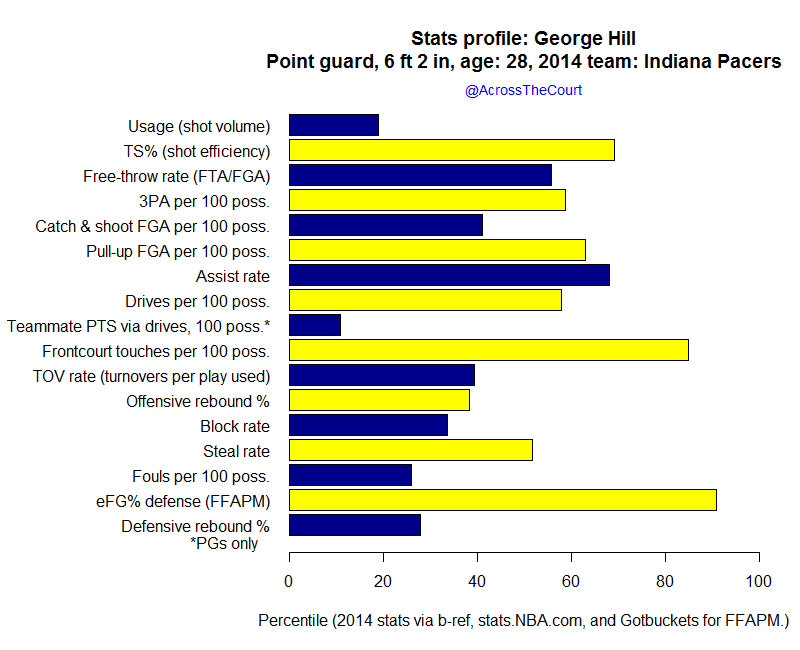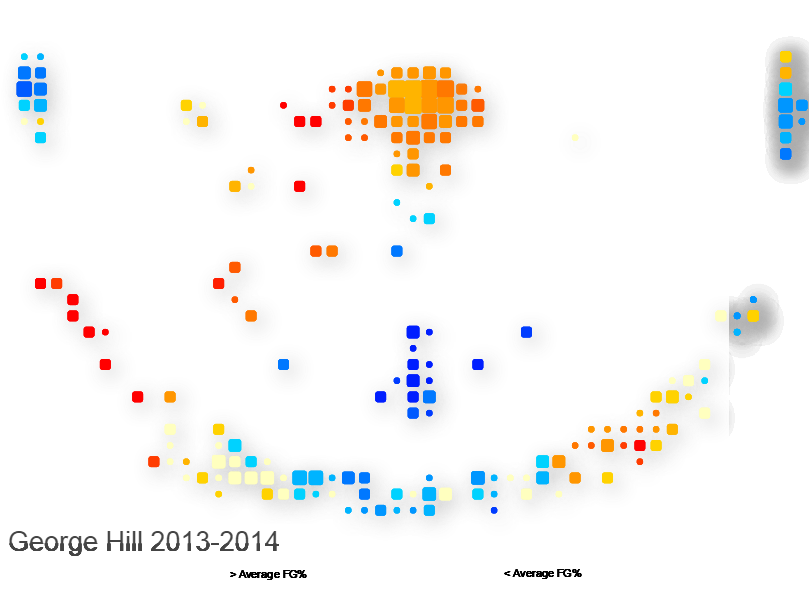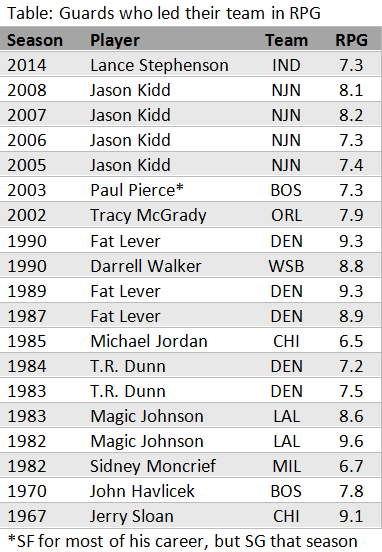What’s distressing is how quickly the darkness can fall. With Paul George breaking out offensively and the Pacers playing some of the best defense ever along with Hibbert as a lock for Defensive Player of the Year, while remaining the Kryptonite for the Miami Heat, the future was bright. But in just a few months, Hibbert became a joke, they offered little resistance to Miami, they lost Stephenson to another team, and Paul George suffered a gruesome leg injury. Indiana’s at a crossroads, and they may completely revamp the team or just brave the setbacks and soldier on. A few wins or losses before the trade deadline could decide their fate.
2014 in review
The Pacers had a strange, Dr. Jekyll and Mr. Hyde season. From the beginning of the season to January 16th, Indiana outscored opponents by almost 10 points a game and held them to 95.5 points per 100 possessions. That defense over a full season would have been the best ever since the Russell-era Celtics. The Bulls, for example, were giving up 5 more points last season, and they were the second best defensive team. With a mere league average offense, Indiana’s defense gave them a 67-win pace. But for the rest of the season they went 25-19 and were actually outscored by their opponents. Their offense slipped, and their defense took a massive hit, ballooning eight points to a defensive rating more like mortal teams like the Thunder and Wizards. What’s strange is that this happened before, and 2013 was a mirror season where they struggled before the all-star break and took off afterwards.
If it happens once, we can chalk it up to the strange wrinkles and randomness of the basketball universe. But their dichotomous seasons are bizarre and it’s difficult understand what’s really going on. Maybe it’s just coincidence and the result of bringing on Evan Turner to disrupt a defense that was already on the way down due to a heavy dose of regression to the mean at the same time Paul George’s own percentages fell back to Earth. Whatever the case, Roy Hibbert is near the nexus of the problem.
Roy Hibbert, before all-star break:
2013:
10.0 PPG, 8.3 RPG, 95 offensive efficiency
2014:
11.8 PPG, 7.7 RPG, 104 offensive efficiency
Roy Hibbert, after all-star break:
2013:
15.7 PPG, 8.2 RPG, 111 offensive efficiency
2014:
8.9 PPG, 4.7 RPG, 88 offensive efficiency
Changes
Exit: Lance Stephenson, Danny Granger, Evan Turner, Rasual Butler, Orlando Johnson, Andrew Bynum.
Enter: C.J. Miles, Rodney Stuckey, Damjan Rudez, Shayne Whittington.
Although per year the contract Charlotte offered was only $200,000 more, Stephenson and Indiana couldn’t agree on contract length. Indiana wanted to lock him up long-term, past the lucrative TV deal and taking up much of his prime. Lance wanted a three-year deal — and that was it. He was gone. A few weeks later, and George broke his leg and the Indiana’s situation at the wings was dire. Turner was an embarrassment of a move, and it cost them Granger, who looks a step away from early retirement anyway. Paul George is effectively on the exit list, of course, and will probably not play in a single game this season. The Pacers will replace their key starters with C.J. Miles, Stuckey, and a host of fringe-NBA talent. Perhaps someone will be a diamond in the rough, but as it stands it’s a major downgrade on talent, mostly on defense.
Player spotlight
One of the more overlooked starters in the league, George Hill will have a greater burden this season with Indiana’s sudden downturn. Hill’s usage was around the 25th percentile, but before that he was consistently near the league median. His efficiency, even with a higher usage, has usually been above average, thanks to a high-rate of three’s on a healthy percentage. But he has the assist numbers of a shooting guard and has never looked like a prototypical point guard. He drives infrequently for a PG and generates one of the lowest rates in teammate points via his drives for his position.
Defense is Hill’s calling card and this is where he’s overlooked. He’s criticized for his offense, but most championship teams in the past couple decades have had a low usage/assist point like him. His block and steal rates are unremarkable, but he’s in the 88th percentile in eFG% defense — that’s outstanding for a guard. It’s at the same level as Avery Bradley and only Conley and Bledsoe rate better as point guards with a substantial amount of minutes. Other metrics corroborate his skill there. He’s a sturdy, strong guard with a 6’9″ wingspan and instead of gambling he plays a more conservative defense and bottles up opposing players. But Hill doesn’t get the same kind of respect that the aforementioned guards do.
Given the shot chart below, Hill’s a top of the arc three-point shooter, and looking at his other seasons he’s generally above average with some “red hotspots” sprinkled in there. He’s not a corner shooter, however, and never has been. He’s also not a midrange shooter — that’s probably too aggressive for the passive Hill. He’ll take three to four shots a game inside, but he’s a good finisher inside and should increase his rate with all the talent absent.
Matched-up versus a bulldog point guard in Lowry, George Hill displays his off-ball skills. In the first video of the playlist below, he spots up for a three from a Paul George post-up. Hill has a good in-between game too, which you can notice from the shot chart given the wide range of shots in the paint, able to hit those awkward shots from 3 to 10 feet. There’s an example of that in the second video with a push shot from near 10 feet on a break. Hill wasn’t even used as a point guard in the third clip, finally getting the ball a couple passes later and hitting a three off the dribble behind a pick. Hill gets a wide-open three in the last video when the defense collapses on David West. What’s important to note is how he’s used in the offense. He’ll certainly touch the ball, but not for long and he doesn’t create a lot of opportunities for others.
When you showcase most point guards on defense, you usually show steals, but with Hill we can use blocks. In a game versus Charlotte (link’s also here) and against Kemba Walker, he stays with the quick scorer as the defender dances around a pick and contests close enough to Walker’s shot that he gets credit with a block. In the second clip, he rushes back on defense and snuffs out a fast break lay-up attempt and then hits the deck scrambling for the loose ball, which goes to Indiana. His defense helps win the game in the last video. When Charlotte is down two points with a minute to go, Kemba tries going around an Al Jefferson pick, but Hill fights through and stays with him, and blocks him as he rises up for a jump shot.
Hill’s a low impact point guard, rarely distributing or scoring a high amount of points. But he’s a very good defender, adept at fighting through screens and staying at the hip of his man. He doesn’t take too many risks and he relies on using his long arms to contest shots and force awkward attempts. On a bad team, especially on offense, he’ll be heavily criticized for his lack of aggression, but he’s ideal for a contending team with a ball-dominant wing player. He’s in the mold of Derek Fisher, a steady, low maintenance guard and a plus defender.
2015 projected
One of the best cases of recency bias is Roy Hibbert. If Hibbert’s poor half-season had occurred before the all-star break he’d be receiving a lot more praise and less criticism. What people forget is how good his defense has been the past couple seasons, and how the problems with his offense mostly have to do with his overextended role on a poor offensive team. Most defensive centers have no range and shoot far less often. The concerns about his rebounding are overblown too. If Hibbert is a liability on the boards, then how did Indiana rank second in defensive rebounding? What Hibbert does is box out his man to allow one of their wings, or West, to grab the rebound. Lance led the team in rebounds per game, but this was partly by design. Looking at a seven-year study of how players influence their team’s rebounding, Hibbert actually rates very high. (If you ever worried about players “stealing” rebounds from teammates and inflating their stats, this is what you should cite.) If you total a player’s influence on teammate rebounds and his own defensive rebound rate, you can get his total influence. Hibbert ranks 55th out of 899 players, and right next to notable rebounders like Reggie Evans, Garnett, and Blake Griffin.
Speaking of rebounding, it’ll be interesting how the rebounds will be distributed with Stephenson gone and George injured. Stephenson accomplished a rare feat as a guard who led his team in rebounds per game. Setting the qualifying mark at 1000 minutes, Stephenson was only the 12th player to accomplish such a feat. (Given which players are masters at this, I wanted to name this feat “Magic Fat Kidd,” but that would be uncouth.) It’s a vexing, bewildering list of legends and odd players, and it’s the perfect place for Stephenson. (On another note, Desmond Mason nearly made the cut, but had only 952 minutes for the Bucks in 2003.)
A few months ago, a strong campaign for putting Lance Stephenson into the all-star game was reverberating throughout the media. Not only was I hesitant to endorse this because it would make him too expensive for the Pacers and would limit one of the few good eastern conference teams — and that worked in some respects, as Charlotte gave him a large contract — but Lance was one of the more overrated players. One type of overrated player is the offensive leader of a team that wins through its defense, like Isiah Thomas in some circles who rate him as high as MVP-caliber players or Rip Hamilton. He had a below average usage rate on what was the 24th best offense in the NBA (adjusted for strength of schedule) and 4.6 assists a game. He’s a good defender, but far from the best where Paul George and Hibbert were clearly the stars there. He’s certainly no lock for the all-star game. Kyle Lowry, for instance, shot more often on the same shooting efficiency with over twice as many assists with good defense.
No metric saw him as the driving force in Indiana’s success. What happens is that an exciting, unique player gets the attention of fans and people fill in their own perceived value of him. I have a metric that gives a lot of credit to shot creation and spacing, two of his strengths, and he still only saw him as a neutral player on offense, not a star. Indiana won’t miss him as much as some people think, and some dire projections are basically assuming he’s a core, all-star piece.
The problem lies in losing Paul George for the season and, partly, replacing Stephenson’s defense after an off-season where they added no one of significant value. Their offense actually won’t decline too far — they did bring in offensive players to fill the void, after all — but their defense will likely fall out of the top five. For a team with a poor offense, this is a fatal change.
We do have an oddly similar antecedent to the fiasco in Indiana. The Bulls lost Rose, and eventually lost other important guys like Korver, Asik, and Deng, and kept on making the playoffs and treading water above 0.500 ball. They filled the gaps with spackle and managed to keep playing top-level defense with guys like Boozer and Nate Robinson in the rotation. Although I think Vogel is not the same coach as Thibodeau, they could run a reasonable facsimile of the Bulls in the injured Rose-era.
Indiana’s offense will still run through their big men to a degree few match in the modern era, but Stuckey may have a large role on offense. His slashing game is a bit different from what they’re used to, and he’s not the distributor Stephenson is. Copeland could even start for them for most of the season, and his outside shooting is needed. Miles will be fine and could have been a half-decent (half as in worse, please note) band-aid, but now they need much more on defense. Miles and Copeland combine to give Indiana a huge boost in outside shooting, which should alleviate some of their issues. On the bright side, Indiana’s offense was uncreative and sluggish last year, so they won’t exactly be wrecking a Mona Lisa. Handing the ball to Stuckey and getting out of his way on offense isn’t ideal, but making the playoffs in the east is remarkably easy and the Bulls did the same with Nate Robinson and Augustin and lived to tell the tale.
Summary
NBA fans and writers are quick to write off teams, but players have too much pride and can work hard just to prove everyone wrong. From an objective standpoint, Indiana would be better off playing the lottery and trying again when George is healthy, but there’s no indication the coach is quitting and the players won’t either. Their wing defense is going to drop more than it has for any team since perhaps the Bulls in 1999, but Stephenson isn’t an irreplaceable star and the Pacers still have much of their league-leading defense in place. In the east, you have to fall a long way from 56 wins to hit the lottery. The Bulls survived losing Rose and various pieces, relying on their defense, and Indiana could do the very same.
Predicting the Pacers is a fool’s errand at this point, but if I had to guess I’d say they will start the season well, remain above 0.500 for a while, will hit some point mid-season where they completely fall apart, make the playoffs by the skin of their teeth, and will be blown out by LeBron and friends in the first round.
Note: revised projections and new injuries have dampened my enthusiasm at them making the playoffs.
Wins: 35
Losses: 47
Conference rank: 9th
League offense rank: 27th
League defense rank: 9th
Edited 10/27/14























